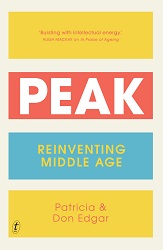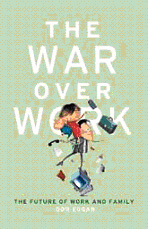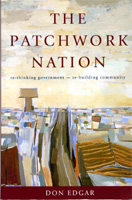
Patricia Edgar & Don Edgar

Challenging the Conventions of Work-Family Programs
AHRI Conference Paper 22 May, 2001
Dr. Don Edgar
Corporate Work-Family Awards and good-news media stories about family-friendly companies hide both the reality of most workplace cultures and the changing nature of family life and its likely links to work practices. This paper argues that most companies have not understood the business argument for taking into account employees' family responsibilities; that the work-family debate has been muddied by discussions of the work-life balance; and that companies ignore the real demographic challenges they face in the coming decades which will alter the nature of both work-family and work-life policies and programs. The core issue is the growing diversity of the workforce and competition to become an employer of choice. With younger recruits and experienced workers adding their new values and demands to the design of work, employers can no longer continue to pigeon-hole 'work-family' as a peripheral business issue. They will need to become more active in encouraging a more family-friendly environment, both within and outside the workplace.
I do not want to spend too much of my time in this address on what work-family programs involve, how they developed, or what their cost-benefits clearly are. I'll have to do a bit of that, just to set the current situation in context and remind you of how far we have come.
But I want to challenge some of the standard approaches to work-family issues and get you thinking about the new challenges we face as we move into a globalised, service economy and out of our protected national cocoon.
Background Introduction
We have come a long way since the days when outside life was regarded as irrelevant except insofar as employees could be motivated by levels of pay (the old industrial relations approach),
During mid-century, the human relations school (Elton Mayo, the Tavistock Clinic) discovered that there was such a thing as the informal organisation which could damage productivity, and the social needs of employees were in fact linked to how well they performed their roles at work.
Then we started calling it Human Resource Management, with a more strategic focus on catering for human needs, investing in people and encouraging discretionary effort. But it was not really until the 1970s that studies such as those of the Rapoports recognised the inevitable two-way link between work and family and told employers they needed to assist people in balancing their work and family responsibilities or they would suffer through absenteeism, poor morale, stress and poor performance outcomes.
You should all know what drove the work-family balance issue as it stands today. It was the need for and the return of married women to the paid labor force after the period of familism that followed World War 2. For a short time in history, getting married and having kids was almost a universal experience. The Baby Boom generation is the result. In those post-war years of reconstruction, a depleted nation needed re-building, families needed to be re-established and one paid job was enough to meet the needs of most ordinary families. No en-suites or family rooms in those days, no four-wheel drives for Mum and the kids, no dining out at fancy restaurants - life was fairly simple and needs were basic.
The way other nations handled the need for rebuilding is a salutary reminder of things to come.
Places like Sweden had a clear philosophy about the future, about equality and about the importance of early childhood. They recognised early that women had equal rights, and that children needed the best possible early childhood care and education if the nation was to rebuild successfully. Family responsibilities had to be shared, in this case with the state, not necessarily by the husbands.
Germany and France, Italy and other states had the same problems, but their conservative values meant providing generous family allowances and little child care, the goal being to keep women at home. Even today in Germany schools close at noon, in France at 3 pm, on the assumption that mothers will be at home to care for them. Schools in Australia are not particularly family-friendly either.
In the USA, marriage boomed and the Baby Boom followed, as it did across the western world. But American women had had a taste of freedom and divorce numbers grew as they asserted their right to work and not be the lackeys of men. Their economy boomed, expectations about standard of living grew, people wanted more than a two-bedroom home, the car industry revolutionised the cities, created suburban life and boosted the consumerism that makes two income-earning adults per family a necessity rather than an indulgence.
What did not happen, however, was a commensurate change in the structure of work. It has still not happened, and I guess that is the main theme of my address today - despite the impact of communications and the global economy, work is still designed on an industrial age male model and we are ill-equipped to face the challenge of trends in our demographic makeup or in the values that will impinge on the way future generations will live their lives.
Work-family balance is still a novelty tolerated on the edge of those things still considered more important - profit, management control and shareholder interest.
Most jobs were designed on the model of family life that characterised the bulk of the post-war population - Dad leaves home after breakfast, Mum stays at home, delivers the kids to school, cleans house, cooks the meals and welcomes Dad home again after his evening commute. Work was done away from home, and it was designed to fit a routine time structure, with fixed daily work hours and the weekend devoted to church and family. Dads were the earners, that was how they cared for their family. If a woman wanted a job, she had to fit in to that 9 to 5, or 8 to 6 pattern. It was her problem, their private family problem, if the kids had to be driven to child care, or they got sick and couldn't go to school, or the husband complained because his dinner wasn't on the table when he got home just after her. Her earnings were welcome, but she had to carry the load, not usually him, and certainly not the employer.
Work was designed for men, careers were structured for men, pay rates were set for men, and the women just had to fit in as best they could if they wanted to work in a male world. Family life might be addressed as an issue, but only because it hindered work productivity.
It all sounds so unrealistic, so stupid in retrospect, I marvel that the system functioned at all. But then I look at what still happens and I realise we're all pretty stupid still. At least by the 1990s we had recognised the problem was one of balancing or juggling responsibilities. You had obligations at work, to perform and be productive, but you also had responsibilities at home, to your partner, your kids, maybe even to other relatives.
By 1991 Australia had ratified the International Labor Organisation's Convention 156 on Workers with Family Responsibilities. This was driven by the inevitable return of married women to paid work. They were better educated, older at age of marriage and older when they first gave birth, so their attachment to paid work was much more than casual.
Australia was ahead of many other countries in legislating for equal opportunity, affirmative action and anti-discrimination, but it is true to say that most work-family policies in the 1990s were seen as 'women's issues' and not particularly relevant to men. Too many workplaces implemented work-family arrangements that were program-specific while barely touching the dominant male culture of the workplace itself. And it is only in the last few years that governments have begun to acknowledge that we face a pool of employees who have very different family circumstances and very different social values from those on which most work-family programs have been based.
Employers and managers have to realise that the nexus between work and family has changed forever.
More couples with children are both in paid work; the marriage rate and birth rate are down, with one in every five households now a single person household; divorce has increased by 300% since the 1960s; employees report high stress levels and lack of time for loved ones; and companies are seeing the fallout in lack of commitment and high staff turnover.
Now more than ever, we need women in the paid workforce. Our birthrate is down to 1.74, immigration is restricted, there are not enough new entrants into the labor force to drive the new economy, certainly not enough new male entrants, yet we still have employers who think women wanting jobs on their own terms are a damn nuisance. Moreover, we still have employers who are reluctant to employ anyone over the age of 45, yet these are our most skilled and experienced people and those over 45 will comprise a third of our workforce by 2005. Worldwide, mothers comprise 32.1% of the paid labor force, their participation rate rising from 48.3% in 1973 for OECD countries to 61.6% in 1993.
The labor pool has changed forever and in a competitive global environment no-one can afford to ignore where most of the talent lies. If an employer cannot handle diversity then they may as well give up now, the world won't wait for their troglodyte attitudes to catch up.
Not to put too fine a point on it, business has finally recognised that workers do have a life outside the office, and (very reluctantly) that the new employee is in a position of power to negotiate his/her own time, place and conditions of work.
A Dozen Challenges on Work-Family Issues
This leads me to offer a list of what I see as the most significant changes in the nature and meaning of the work-family issue for your consideration. There are twelve points to make, but I won't elaborate on all of them, in the interests of time. The paper will be available on disk after the conference.
- First, I think work-family balance is the wrong term.
Life is never in balance, a state of equilibrium, it's always a rocky road, with one extreme or another to handle. When you're young and single, working long hours is fun, you have your mates in a common enterprise, you work hard, play hard. Once you have kids, there are other demands, the boss cannot take precedence or the marriage is on the rocks. Ironically, it is married people who actually work the longest hours and earn the highest income, they have that incentive to do the best by their families. If there's a new contract on the way, or a report to be written, the notion of balance is absurd, you just do it and let other things go, until you can slow down again and think about other things.
Indeed, why would we want equilibrium, balance, in a rapidly changing economy? We live in a risk society and we have to learn to manage risk, welcome creative destruction in our corporations and businesses if they are to keep up with the challenges from a global economy. As Daniel Akst wrote in the New York Times recently, 'balance doesn't build businesses, cure diseases or change the direction of history … It takes a kind of mad genius to reach some goals - a kind of unbalance that has somehow fallen into disrepute. Fortunately, workaholics are still with us. … For what is genius, I ask you, but the capacity to be obsessed?'
Ellen Galinsky suggests we use the word 'navigating' instead of balance - we navigate work demands and outside life/family demands, we don't balance or juggle them like a circus clown. Navigate is a better word because it suggests an ongoing process, not an ideal state; it acknowledges the fluid interchanges between individuals, their families, work and community interests instead of treating them as separate spheres. To navigate implies you have to be well attuned to your surroundings, watching for obstacles, staying on course; and you don't have to do it alone, there's usually a team, a crew of people who work together to keep the ship on course.
However, I worry that the word navigate is also too passive. It implies that the course is set, the shallows and storms are there for us to avoid, and the ship belongs to someone else. It implies there is a clear destination, that we know where we're going and someone has a map or chart to follow. I don't think that is real in today's world. I'd like a more dynamic term to describe what we do in making our arrangements between work and life demands.
The term I prefer is 'negotiate'. Negotiation is better than 'choice' because choices are never just there to be chosen freely. There are many options in modern life, and the task is now much harder than simply fitting into the clearly-defined role of male breadwinner, female housewife, line manager or union organiser. The essence of modern life is optionality, but the only way to survive is to negotiate your way towards what you want, you don't just get what you choose.
Sex has always had to be negotiated, but marriage once conferred certain rights and obligations. Marriage today has to be negotiated too, as has whether or not the wife will work outside the home, whether and when you have children, who will manage their care, how the household will be run. Through the various stages of life, you have to negotiate with bosses, partners, children and others to get what you want. You negotiate your way through alternate options.
I like the term negotiate also because it suggests to me the importance of power - if you don't have power in any relationship - whether personal or workplace based, you have less chance of living your life as you wish. Women know this is true, so do workers who combine into unions to give them greater clout than acting as individuals, but every employee has to negotiate life's options, bargain, trade off one thing against another. And the result is not necessarily balance, it's the best we can manage given our circumstances and our relative bargaining power.
- The second point I want to make is that I am somewhat sceptical about how much we have advanced towards a culture in which family life and the quality of personal life are treated as important, either in their own right, or as factors contributing to job performance and productivity.
I was in London recently, at the Blair Government's International Worklife Summit. It was supported by a group of top businessmen (Employers for Worklife Balance, chaired by Peter Ellwood of Lloyds TSB) and by the Department for Education & Employment, but their whole focus was on proving the cost-benefits of work-life programs and family-friendly workplaces. In fact, there is now so much research on the cost-benefits that no-one need do much more, but the employers remain unconvinced. For one thing they don't read the research, for another they don't understand or ask their employees what actually are their outside needs and responsibilities and how they spill over into job performance, and even when they have work-life programs in place less than a third bother to monitor or evaluate the effects on morale and performance. The real problem is that British employers don't believe private family and life concerns are their problem. Nor do they believe it is the government's job to legislate for better leave arrangements or more flexible workplace practices.
Scratch the surface in Australia and you will find the same. The Summit degenerated into a glib presentation by a few 'good' companies like IBM and PriceWaterhouse about what they do, but the Minister took a hammering at the dinner from some senior executives and backed off rapidly because an election seemed about to be called.
In fact in the UK, a third of employers were not even aware of the new parental leave regulations. Few UK employers offer family leave arrangements; 65% of workers say they are consulted on work-life balance matters, but 64% of workplaces fail to monitor what is being done. The latent demand for more flexible and family-friendly work practices is huge, yet the employers don't know and don't seem to care. The 2000 Survey found a very low incidence of flexible work time practices other than part-time and shift work. There are few facilities to help employees balance family responsibilities with work demands, not even the provision of information services about child and elder care.
The survey found 35% of British employees would like a compressed working week, a third would like to work from home, more men than women want flexible work arrangements, and 55% of part-time workers do not want full-time jobs, with a third of such men saying family demands make part-time work better for them. There seems to be an ingrained hostility on the part of employers to looking at the changed facts of life and the widespread need and advantages of flexible, family-friendly workplace practices.
In terms of best practice in work-family programs, the United States is not much better. Despite the constant stories of best practice family-friendly workplaces, only a minority of American workers have access to any dependent care benefits; only 11% have access to on-site or near-site child care; only 50% can take time off when a child is sick; although some improvement is apparent in that 75% feel comfortable bringing up personal and family issues with their supervisor.
- The central issue is that of control - employee control over the how, when and where of work versus the employer's distrust of workers and the managers' fear of losing control.
As Peter Ellwood put it at the British Worklife Summit: 'The key is, how to become an employer of choice, how to recruit, retain and creatively deploy the best talent available. People need and demand control over where, when and how they work. But trust is crucial. How do we redefine the B2E contract when managers fear losing control? We need to build a corporate culture of trust, flexibility, reliability and community of interests.' Again, negotiation of the work-family, work-life balance is the burning issue, with both sides standing to gain.
So that is my third comment: 'presenteeism' is the enemy of real change - being seen in the office and appearing to be working, even when, after a long day's work, you're not being at all productive in the hours 5 to 7 pm and everyone would be better off if you went home, saw the family, or went off to play squash and have a beer. This sort of 'face-work' is absurd in the context of emphasising quality performance, outcomes rather than inputs, yet employers and managers still fail to get the message.
If only employers would realise how counter-productive is a long work hours culture, we might have less of the following sort of relationship problem than we have at present -
- My fourth point is that we have been too simple-minded and business-focused about the work-family nexus.
What is now clear from the research, but pretty much ignored in the Australian discussion about work and family, is that the 'spillover' from work to home is much more frequent than the 'splashback' from home to work. That is, work life is an important source of employees' personal problems at home which, in turn splash back into the workplace, affecting both performance and productivity.
This means most workplaces have got it wrong. They have EAPs (Employee Assistance programs) that address personal problems, but fail to address and reduce the extent to which jobs contribute to those problems. It's no use sending someone to marriage counselling if the job demands very long hours or is totally unsympathetic when a family crisis occurs.
To put it crudely - 'It's the work, stupid…' It's not that family life is the problem in isolation from the way work is structured.
- Fifthly, the research also shows clearly and repeatedly that job satisfaction, loyalty, commitment and performance are more influenced by workplace support, a culture of family-friendliness and understanding (especially on the part of supervisors), good co-worker relationships and job design flexibility than they are by earnings or by access to specific benefits.
So it's no use just setting up a few EAPs or separate work-family programs. You must address the quality of the job, allow for flexibility in the redesign of work so that employees can manage both sides of their responsibilities, and develop a supportive workplace culture which carries the message that life outside the workplace is valid, and significant to the bottom line of the company.
- Sixth, as I suggested earlier, the discussion has to move on from women and child care to a broader definition of family life, and to some extent it has.
The most obvious change is the ageing of the population and the fact that every employee has parents even if they never marry or have children of their own. One in every five employees is already a member of the 'Sandwich Generation', both raising children and caring for elderly relatives. In the USA in 1997, 25% of the labor force had provided elder care in the previous year, with an average of 11 hours per week being spent on their elders, men equally with women. Elder care used to be another job dumped on women, but no more. Divorce, having both partners in paid work and the new demands of women have put paid to that. She may look after her own parents, but she's not going to look after his, and he is less likely to have sisters to dump elder care responsibilities onto. In fact, a third of both male and female employees in the past year had reduced their hours or taken time off in order to cope with aged care responsibilities.
- A seventh comment follows from the demographic changes I've been talking about: the work-family discussion has to consider what it now means to be an employer-of-choice, and the shift in employees' values about the meaning of work.
Even the most traditional employers will be forced to change because of the shift in values of the new S-Generation, the Solo Singles who comprise nearly a third of our total population. Their motto is in essence - 'I have a life outside work, and if you won't acknowledge that, goodbye!'
It's pretty obvious that life interests and needs change over the life cycle, so one size won't fit all. Young graduates and the Solos are not interested in child care, but flexibility and personal growth opportunities figure large.
As one single woman put it: "I never married because I have three pets at home that answer the same purpose as a husband. I have a dog that growls every morning, a parrot that swears all afternoon, and a cat that comes home late at night.'
As the recent AIFS study on parenting shows, one in five adults say they simply don't like children. (As one commented: 'I don't like them. They scream, shit and want food.') Another quarter say they're just "too bloody old" to have children, and the ABS projects that 28% of those now in their child-bearing years will never marry and never have children.
Why would, or should, such singles have any interest in policies that call themselves 'work-family'?
There is a resurgence in the search for meaning in what seems to be an increasingly meaningless world, and I am reminded of Studs Terkel's (1972) statement about work:
'Work is about a search for daily meaning as well as daily bread, for recognition as well as cash, for astonishment rather than torpor; in short, for a sort of life rather than a Monday-through-Friday sort of dying.'
The new question is not 'What are we doing today?' but rather 'How are we doing today?' The new generation of employees values autonomy and responsibility, they seek a sensible balance in their lives, want jobs to offer them both career training growth and personal development opportunities, and they have the power to negotiate actively for what they want on the job.
There is plenty of evidence of this change in people's values about work.
A recent Queensland survey of job-seekers found the most desirable job characteristics were: 81% a happy work-life balance; 74% career development opportunities; 68% quality leadership from the management team; 55% good corporate ethics; and 48% training opportunities in the job itself.
The recent report on the '25 Best Employers to work for in Australia' lists seven key factors: leadership by creative and unusual people; job tasks that are demanding and meaningful; the culture and purpose of the organisation; quality of life; relationships between employees and with bosses; the overall salary compensation; and opportunities in the organisation to grow and learn, to stretch one's capacities and limits.
A Price Waterhouse survey of 2500 university students found that most of them expect to work an average 47.1 hours a week; will stay 4 years with their first employer; 64% put balancing work and life as a top priority and will choose an employer who values that balance, provides a good starting point for personal career development, inspiring colleagues and a competitive salary. For them work-family issues are not yet a priority, whereas they see their next ten years as a time for personal development and growth.
What this clearly suggests is that work-family programs are not the answer on their own to being an employer of choice who can attract and retain the best talent around and I shall return to this in a moment.
- My eighth point is that we have to avoid confusion between work-family programs and the notion of work-life balance.
While not everyone has a 'family' in the traditional sense, some claim to have a dog that is family, or a goldfish, and everyone has friends and relatives that can figure in family-like obligations.
I prefer to reserve work-family as a term for those family responsibilities you cannot avoid. As I argued in the Australian Bulletin of Labour last September:
"A child cannot be ignored; a parent with Alzheimer's cannot be left alone; a dissolving marriage cannot but interfere with concentration and performance; a teenager with a drug problem demands parental attention. In contrast, playing a game of golf or two may be good for one's morale, but it is not an obligation as such."
Once the Singles do marry and have children, however, they will want time to spend with their family, unlike the macho men of old; their partners will be employed and will demand more equality in family tasks. Older workers will not need child care, may need help in caring for their ageing parents, but essentially will want time to pursue interests outside the workplace.
- The real issue for workplaces then (and this is my ninth point) is that of managing diversity and thinking creatively about employees as whole people wanting different things out of work, family and life in general at different stages of their lives.
- My tenth point is that work-family programs are not, in and of themselves enough. In fact I am suspicious of programs that barely touch the processes that make up what we call the culture of the workplace - 'the way we do things around here'.
One thing that's clear from the research is that work-life programs are used more frequently by managers and professionals than by those further down the pecking order. It's easier for them to take time off without losing pay and this probably accounts for some of the cynicism about published work-family policies in many workplaces. It's one thing to 'walk the talk'; it's quite another to have different conditions and penalties for those without negotiating power.
The best examples of good work-family practice involve a clear involvement of management, a complete culture change that affects work processes and not just the implementation of separate work-family programs.
AMP won the top Corporate Work-Family Award in 1998 and offers very flexible family-related leave, family information services and a culture that does not make workers feel guilty because they happen to have family obligations that intrude on work hours every now and then. AMP sensibly monitors its results: they reduced staff turnover from 20% to 13%; obtained a 90% return rate for women from maternity leave through flexible work arrangements; and calculate it would have cost them between $50-80,000 to find and train replacements for such women. Lend Lease has benefited from increased morale and commitment because of its flexible work options and its encouragement of employees to take days off to help community organisations. Minter Ellison has shown that even a law firm, with its billable hours, male-dominated culture, can develop a family-friendly culture, offering alternate career paths, information about child and elder care, a parental network group.
- My eleventh point is there are still obstacles to change as well.
For example, Barbara Holmes's annual studies over a large range of Australian workplaces showed that:
- in 2000, 63% were confident that work-life initiatives were progressing in their organisation, but 34% felt they could improve and were not having the impact they would like, and 13% reported backsliding, a losing of ground in corporate implementation of family-friendly workplace practices.
- 24% had observed increased staff turnover due to a lack of flexibility and 43% reported increased turnover due to excessive workload pressure
- 54% disagreed when asked did they believe the company was doing all it could to help staff maintain a work-family balance
- 55% had seen an increase in the average hours worked by employees
- only 19% had conducted any evaluation of their work-life, work-family strategies
Imagine any company not evaluating the effectiveness of new technologies, new work processes designed to increase productivity. Quite clearly many companies pay lip service to the work-family issue, but they can't even be bothered finding out whether and how it makes a difference to either morale or the bottom line.
12. But my final message (and this rounds out the full dozen) about work-family policies and programs is that they cannot be left to employers and workplaces alone - they are a community matter.
It doesn't matter how family-friendly an individual workplace may be, if employees live in a community that is in itself unsupportive of family life, of children, young people or old. If there are few child care places, or little variety in the sort of child care provided, no one employer can make up for that shortage.
If the schools have no social workers, guidance officers, no before- or after-school care arrangements, then how can any employer counteract the problems of youth alienation, home-alone kids, behaviour problems that splash back into the workplace in the form of employee stress, poor performance and problems such as drugs and violence? When an employer finds over half of their workforce are aged 45 plus, and have elder care responsibilities, what are they to do? Let them all take days off, build aged care centres at the workplace, provide home care nurses for their employees' parents? Not likely, though some of that might be a good thing and not beyond the realms of possibility.
Instead, employers in the future will need to become more active themselves in negotiating for a family-friendly environment. They can do this in two ways.
One is to become what I have called a 'New Links Workplace', forging external links with all those agencies in the community from which they draw their employees and lobbying them to develop better services. They can assist local community organisations and schools with management and accounting skills; they can help them apply for grants from government and elsewhere; they can invite them into the workplace to offer lunchtime seminars, workshops on topics of concern.
They can forge links with other employers in the same region, share resources and costs so the burden for family-friendly support services does not fall unduly on them alone.
They need also to develop the internal links within their own workplace between occupational health and safety programs, skills development workshops, equal opportunity and anti-discrimination schemes so these are all seen as part of an overall work-family policy rather than as separate and unrelated programs. The holistic approach needs to apply not just to the way the individual employee is viewed, but also to the all-embracing culture of the workplace itself.
The second way is an extension of the above. It will manifest itself soon as a backlash by employers against a government which urges them to be philanthropic, to accept their 'reciprocal obligations' and act as good corporate citizens. Employers do have reciprocal obligations, and the more sensible of them do act as good corporate citizens.
But it is the government's primary role, not the employer's, to ensure that adequate community services and resources exist to support diverse families with their diverse needs and responsibilities. That's what we all pay taxes for, including the companies that do pay tax. Indeed, one could argue that paying due tax is the main obligation of corporations and then it is the government's obligation to ensure that taxes are spent in ways that help citizens carry out their private family obligations in ways that make them productive workers as well as good carers. Unfortunately, the corporate world has become so blinded by the dogma of the free market, of small government, of user pays, that they are now cutting off their own nose to spite their face. No company can thrive when employees live in a toxic community. No economy can compete if its workers lack the supports that make for a balanced and caring life.
The New Links Workplace is one which accepts its obligation to cater for diversity, to arrange work so that workers at a variety of life stages can function effectively both in their work and private lives; but it is also one which sees itself as being in partnership with federal, state and local government, in partnership with schools and non-government service organisations to ensure a supportive community context in which productive work can be pursued.
Conclusion
To conclude then, in my view, the next phase of work-family, work-life policies and programs will involve the forging of new alliances between business and government, between workplaces and communities so that the old dichotomy between work life and private family life will be exposed for the falsity it always was. In a global age, where fixed roles have been made obsolete and every individual has to negotiate their own life course, quality of life can only be ensured through negotiated partnerships with others. Workplaces are vital to the quality of community and family life, but so too are communities vital to the quality of the workplace and the viability of the economy as a whole.
We need to rethink therefore the old approach to work and family and bring it up to date with the new realities of a complex, constantly changing and very challenging future.
Work-family policies have to take a systemic, holistic approach; they cannot be just scatter-gun benefits for individuals or they will fail. They must sit within a broad-based philosophy of flexibility, within a work culture that values the integrity of family life and rejects the old hierarchical, long-hours culture that seems at present to be resurgent.
They must be seen as a strategy to make the company an employer of choice, attracting the best workers no matter what their sex, age, family type, race or value-system, and then, of course, retaining them by letting workers themselves decide how they will structure their lives so they meet both sides of their responsibilities. Employers cannot do this unless they address the entire workplace culture, and unless they address the community context in which their employees live their complex lives.
References:
Australian Bulletin of Labour, Vol. 25, No. 3, September 1999, section on 'Work and Family in Australia', National Institute of Labour Studies, Flinders University, Adelaide.
Bond, J.T., E. Galinsky & J.E. Swanberg (1997), The 1997 National Study of the Changing Workforce, Families & Work Institute, New York
Dempsey, K. (2001), 'Women's and men's consciousness of shortcomings in marital relations and the need for change', in Family Matters, Issue No. 58, Australian Institute of Family Studies, Melbourne.
Edgar, Don (2001), The Patchwork Nation: Re-thinking Government, Re-building Community, HarperCollins
Galinsky, E. (1999), Ask the Children, HarperCollins, New York
Haas, L., P. Hwang & G. Russell (eds.) (2000), Organisational Change and Gender Equity: International Perspectives on Fathers and Mothers at the Workplace, Sage Publications, Thousand Oaks, Calif.
Holmes, B. (2001), Work/Life Initiatives - The Way Ahead Report on the 2001 Annual Benchmarking Survey, Managing Work/Life Balance, Sydney
Hogarth, T. et al (2000), Work-Life Balance 2000: Baseline Study of work-life balance practices in Britain, Summary Report, Dept. for Education & Employment, London.
Russell, G. & L. Bowman (2000), Work and Family: Current Thinking, Research and Practice, Dept. of Family and Community Services, Canberra.
Weston, R. & L Qu (2001), 'Men's and women's reasons for not having children', in Family Matters, Issue No. 58, Australian Institute of Family Studies, Melbourne.
Work & Family Unit, (1998), Work and Family State of Play 1998, Dept. of Employment, Workplace Relations and Small Business, Canberra.









